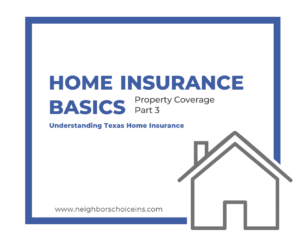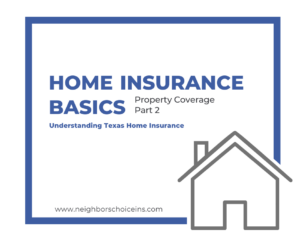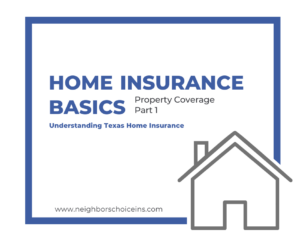Texas auto insurance policies vary company to company and even insurance companies have various auto insurance policies to choose from. In this blog, we will go through the basic documents included in the Texas auto insurance policy and show you where you can find information specific to your Texas auto insurance policy.
A Texas auto insurance policy consists of the Policy Contract, Declarations and Endorsements applicable to the policy. You must consider the contents of all documents in order to determine the coverage you have.
Under Texas law, the insured has a duty to read his or her insurance policy and is bound by its terms.
Declarations Page
An auto insurance Declarations Page (Dec Page) is an overview or summary of your insurance policy coverages. The information shown on the Dec Page includes your name, address, included and/or excluded drivers, vehicles, coverages, additional interests and premiums. The Dec Page also includes the name and contact information of the insurance company and your insurance agent/agency, your policy number and policy effective dates.
Policy Jacket/Policy Form/Insurance Policy Contract
This document goes by many names and it is a document that contains all policy language that defines coverage and provisions for your insurance policy. The Policy Jacket is used in conjunction with the Declarations Page and Endorsements to show a complete picture of your coverage.
There are many sections included in this multi-page document.
- Agreement – The Agreement specifies what the insurance company agrees to do in exchange for the premium you pay.
- Definitions – This one’s pretty self-explanatory. In the Definitions section, the insurance company defines the key words and terms used throughout the Policy Jacket. Some examples of words that may be defined include: You and Your, We and Us, Minimum Limits, Bodily Injury, Property Damage, Your Covered Auto and more.
- Part A through Part D – Each of the following: Part A through Part D have their own breakout of sub-sections. They all have their own special Insuring Agreements, Exclusions and Limits of Liability as well as unique sub-sections that are customized for each Part. Some examples of the unique subsections include:
- Part A – Liability Coverage – Supplementary Payments, Out of State Coverage, Financial Responsibility, Other Insurance
- Part B1 – Medical Payments Coverage – Other Insurance, Assignment of Payments
- Part B2 – Personal Injury Protection Coverage – Definitions, Other Insurance, Loss Payments, Assignment of Payments
- Part C – Uninsured/Underinsured Motorists Coverage – Other Insurance, Arbitration, Additional Duties
- Part D – Coverage for Damage to Your Auto – Transportation Expenses, Payment of Loss, No Benefit to Bailee, Other Sources of Recovery, Appraisal
There are other blog posts that go into more detail for each of these coverages, so for now, we will just leave the sub-sections as a list/overview.
- Part E – Duties After an Accident or Loss – Here you will find your responsibilities after an accident or a loss as well as the insurance company’s responsibilities after an accident or loss. If you do not comply with your duties after an accident or loss as defined in this section, the insurance company has no duty to provide coverage on your behalf.
- Part F – General Provisions or General Conditions – This section is the catch-all for other provisions that did not fit neatly into the other categories. Things that can be outlined here include: Bankruptcy, Changes, Fraud, Legal Action Against the Insurance Company, The Insurance Company’s Right to Recover Payment, Policy Period and Territory, Transfer of Your Interest in the Insurance Policy, Two or More Policies Issued to You, Termination, Payment of Premium.
This is an important section for many reasons, but one I would like to highlight is that this section contains the rules for terminating the insurance policy – for both you and the insurance company.
- Additional Coverages – If the insurance company offers additional coverages that do not fit into the categories above, they may add a section at the end to address the provisions of the additional coverages. Some examples of the coverages include Roadside Assistance, Loss of Use, Supplementary Death Benefit, and Safety Glass Coverage.
Endorsements/Riders
An Insurance Endorsement, also known as a Rider, is an amendment to an existing insurance contract that changes the terms of the original policy. An Endorsement may add or remove coverage, or change the provisions or language of the insurance policy and may be initiated by either you or the insurance company at any time during the life of the policy. Lastly, an Endorsement may cause an increase or decrease in premium.
Once again, you must consider the contents of all relevant documents in order to determine the coverage you have with an insurance company.
But wait, there’s more….
Just when you though insurance couldn’t get more exciting…Here are some other important insurance documents to be aware of:
Auto Insurance Application
An Auto Insurance Application is a form that provides the insurance company with the information necessary to underwrite the auto insurance policy. Information gathered includes data that helps the insurance company determine whether or not the risk fits within their underwriting guidelines. The information contained in the Application also helps the insurance company determine how much premium to charge for the coverage requested.
The Application will have various statements and provisions that the applicant must acknowledge and will also include language certifying that the applicant has not lied on the application.
Texas Liability Insurance Card
The Texas Liability Insurance Card (ID Card) is a document that shows information very similar to the Declarations Page. However there is no specific information about the coverage on your policy. Some of the information included on the ID Card is your name, address, included and/or excluded drivers, vehicles, insurance company name and claims phone number as well as the name and phone number of your insurance agent/agency, your policy number and policy effective dates. The Insurance Card shows that your insurance policy complies with the state minimum liability insurance requirements for Texas.
The ID Card is used to show proof of financial responsibility in order to obtain vehicle inspection and registration, driver’s license, as well as provide relevant information to involved parties in the case of an auto accident. If you are pulled over for a moving or other violation by a peace officer, you may also need to provide a copy of your ID Card. In recent years, most insurance companies provide electronic records of financial responsibility to the State of Texas. This means a peace officer will likely know whether or not you have insurance by simply pulling up your vehicle information in their database.
Verification of Insurance
Some companies provide a Verification of Insurance to be provided to lienholders and/or additional interests. A Verification of Insurance includes a bit more information than the ID Card, but not quite as much as the Declarations Page. Some of the information included in the Verification of Insurance is your name, address, included and/or excluded drivers, vehicles, insurance company and insurance agent/agency name and phone number, your policy number and policy effective dates. One piece of information that is often times omitted from the Verification of Insurance is the premium.
Conclusion
There are many important insurance documents to consider when assessing your policy coverage. The documents work together to provide a comprehensive picture of your coverage and coverage provisions. It is important to remember that it is your duty as an insured to read your insurance policy because you will be bound by its terms and conditions.
Disclaimer: This blog is for general informational purposes only. Please remember, for specific information about your coverage and your policy, please read your insurance policy. If there is any conflict between the information in this article and the actual terms and conditions of your policy, the terms and conditions of your policy will apply.
Contact Us!
At Neighbor’s Choice Insurance Agency, we can work with you to make sure you’ve got the insurance coverage you need, while at the same time using all possible credits and discounts to make that coverage affordable. Just give us a call at 817-421-8866 or send us a note at info@neighborschoiceins.com. We want to help you meet your goals, and make sure what’s important to you is protected!





